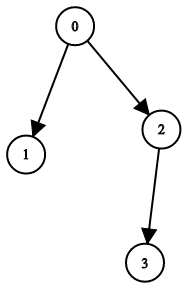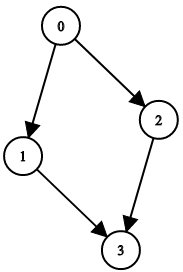- {x}
- Maximum Number of Events That Can Be Attended
- Construct Target Array With Multiple Sums
- Activity Participants
- Sort Integers by The Number of 1 Bits
- Apply Discount Every n Orders
- Number of Substrings Containing All Three Characters
- Count All Valid Pickup and Delivery Options
- Number of Days Between Two Dates
- Validate Binary Tree Nodes
- Closest Divisors
- Largest Multiple of Three
- Number of Trusted Contacts of a Customer
- How Many Numbers Are Smaller Than the Current Number
- Rank Teams by Votes
- Linked List in Binary Tree
- Minimum Cost to Make at Least One Valid Path in a Grid
- Get the Second Most Recent Activity
- Read More...

Validate Binary Tree Nodes
You have n binary tree nodes numbered from 0 to n - 1 where node i has two children leftChild[i] and rightChild[i], return true if and only if all the given nodes form exactly one valid binary tree.
If node i has no left child then leftChild[i] will equal -1, similarly for the right child.
Note that the nodes have no values and that we only use the node numbers in this problem.
Example 1:

Input: n = 4, leftChild = [1,-1,3,-1], rightChild = [2,-1,-1,-1] Output: true
Example 2:

Input: n = 4, leftChild = [1,-1,3,-1], rightChild = [2,3,-1,-1] Output: false
Example 3:

Input: n = 2, leftChild = [1,0], rightChild = [-1,-1] Output: false
Constraints:
n == leftChild.length == rightChild.length1 <= n <= 104-1 <= leftChild[i], rightChild[i] <= n - 1
Solution Explanation: Validate Binary Tree Nodes
This problem asks whether a given set of nodes and their parent-child relationships form a valid binary tree. A valid binary tree has exactly one root node (a node with no parent) and avoids cycles. This solution uses a Union-Find algorithm for efficient cycle detection and root identification.
Approach:
-
Union-Find Data Structure: A Union-Find data structure is used to track connected components. Each node initially represents its own component. When a parent-child relationship is established, their components are merged using the
union()operation (implemented asfind()and settingp[find(i)] = find(j)in the code). -
Cycle Detection: Before merging components, the algorithm checks if a child node (
j) already belongs to the same component as its parent node (i). If they're in the same component, it indicates a cycle (invalid tree), andfalseis returned. Similarly, it checks if the child already has a parent (vis[j]). -
Root Identification: A valid binary tree will have exactly one root node after all parent-child relationships are processed. The algorithm keeps track of the number of remaining components (
n). After the loop, ifn == 1, it means all nodes belong to the same component (one tree), implying a valid binary tree.
Time Complexity: O(Nα(N)), where N is the number of nodes and α(N) is the inverse Ackermann function, which is practically a constant (very small). Union-Find operations (find and union) take amortized O(α(N)) time.
Space Complexity: O(N) to store the parent array (p) and the visited array (vis).
Code Explanation (Python):
class Solution:
def validateBinaryTreeNodes(
self, n: int, leftChild: List[int], rightChild: List[int]
) -> bool:
def find(x: int) -> int: # Find the root of the component
if p[x] != x:
p[x] = find(p[x]) # Path compression for efficiency
return p[x]
p = list(range(n)) # Initialize parent array (each node is its own parent)
vis = [False] * n # Track visited nodes
for i, (a, b) in enumerate(zip(leftChild, rightChild)): #Iterate through nodes and their children
for j in (a, b): #Check both left and right children
if j != -1: #If child exists
if vis[j] or find(i) == find(j): #Cycle detection
return False
p[find(i)] = find(j) #Union operation: merge components
vis[j] = True #Mark child as visited
n -= 1 #Decrement the number of components
return n == 1 #Check if only one component remains (a single tree)
The Java, C++, and Go code follow the same logic, differing only in syntax. The core Union-Find operations remain consistent across all implementations.